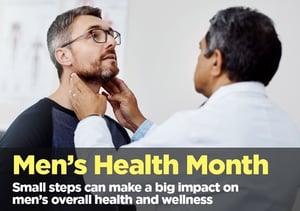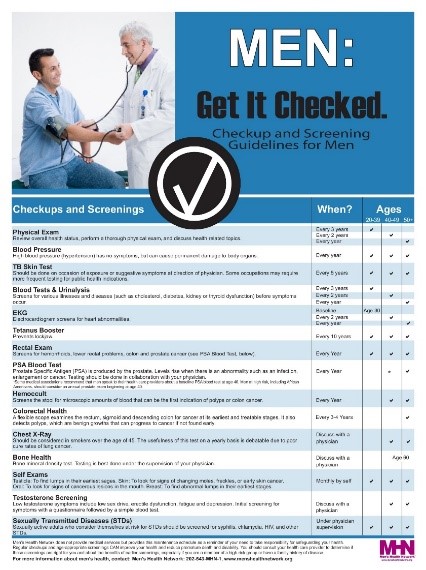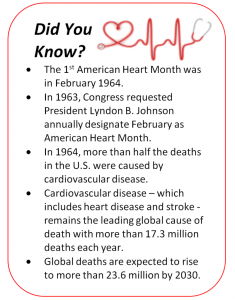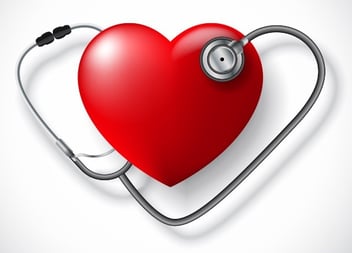June is Men’s Health Month, and while 81% of men can remember the make and model of their first car, barely half of them remember their last trip to the doctor’s office. The average U.S. male lives to 76 – five years short of U.S. female life expectancy at 81 years – and one in five men die before 65.
Men are facing a health crisis that is very preventable, but poor health habits, failure to seek medical attention and dangerous occupations lead men to live sicker lives and die sooner. For example, 75% of premature heart disease deaths are men; middle-aged men are twice as likely to have diabetes and each year, more than 230,000 men are diagnosed with prostate cancer and about 30,000 die from it.
If those statistics don’t get men’s attention, then heart disease, obesity, tobacco use, stress and high cholesterol can all also lead to erectile dysfunction.
How did we get here?
Unfortunately, men have quite a bit stacked against them that contribute to decreased health, including biological, behavioral and environmental factors. When men are healthier, they live longer and happier lives. So why are we still seeing such alarming numbers?
Biological Risk Factors
- Metabolism
- Cholesterol and diabetes are big health indicators for men
- Anatomy/Prostate
- Prostate cancer represents about 27% of all cancers in men and is the second deadliest form of cancer
- Hormones
- Low testosterone can cause a host of negative symptoms
Behavioral Risk Factors
- Smoking
- Smoking contributes to lung cancer, heart disease and emphysema
- Alcohol use
- Medical care
- Men are less likely to schedule their routine doctor’s visits and tend to be more reluctant to approach their doctor with health concerns
- Diet and Exercise
- Accidental injury
- Accidents are the #1 cause of death for men under the age of 44
Environmental Risk Factors
- Risky Occupations
- 92% of workplace deaths are males
- Stress
What can men do to take charge of their overall health? Get back to the basics.
The good news: 70% of men’s health conditions are preventable and the number of health resources for men is growing. It’s good for men to get back to the basics, and while this list of proactive steps may seem obvious to some, it can help men catch health problems early when treatment is most likely to be successful – or, perhaps, avoid them altogether.
- Get regular check-ups and screenings
In addition to watching their weight and aiming for a more active lifestyle, men should maintain their regular health checkups with their doctor. Checkups and screenings allow men to keep up with their blood pressure, testosterone levels, A1c, waistline and cholesterol levels – all good indicators of your overall health. - Eat well , avoid tobacco and limit alcohol use
Eating a balanced and nutritious diet can help protect men from numerous health conditions. Tobacco should be avoided completely in their effort to reduce their cancer risk and alcohol should only be used in moderation. - Protect the prostate gland
A man’s prostate gland grows as he ages, so men should keep an eye on changes in their urinary habits and for urinary problems - Manage stress
Get adequate sleep each night – seven to eight hours – and do something enjoyable each day.
- Protect yourself from unnecessary risks
Wearing sunscreen, proper safety equipment and a seat belt can all aid in preventing injury.
There’s a test for that
The Men’s Health Network (Washington, D.C.), a non-profit educational organization of healthcare professionals and individuals focused on improving men’s health and wellness, provides a maintenance schedule (below) for men as a reminder of men needing to take responsibility for their health. Regular checkups and age-appropriate screenings can improve men’s health and reduce their premature death and disability.

Sekisui Diagnostics testing solutions
Prostate screening
There are certain milestones in men’s health. The first rectal exam between ages 40 and 50 as an initial screening for prostate cancer is a top priority because checking for prostate cancer is important and necessary, just like pulling wisdom teeth and a mammogram. Most prostate cancers are first found during screening with a prostate-specific antigen (PSA) blood test or a digital rectum exam (DRE).
Male menopause
Male menopause and another term, andropause, are terms used to describe decreasing levels of the male hormone testosterone that comes with aging. The group of symptoms associated to age-related changes in male hormone levels are also known as testosterone deficiency, androgen deficiency and late-onset hypogonadism. Any man who experiences symptoms should make an appointment with his doctor.
Hormone testing
In men, about 45-65% of testosterone in blood is normally bound to SHBG (sex hormone-binding globulin) a protein produced mainly in the liver. The remainder either unbound (free testosterone) or weakly and reversibly bound to albumin, which is the main protein in the blood. Risk factors for low SHGB levels include obesity, insulin resistance or type 2 diabetes, hypothyroidism, Cushing syndrome, nonalcoholic fatty liver disease, acromegaly and androgen steroid use.



Share Article